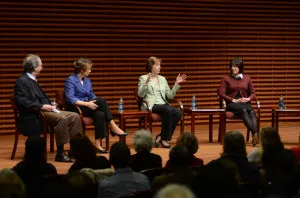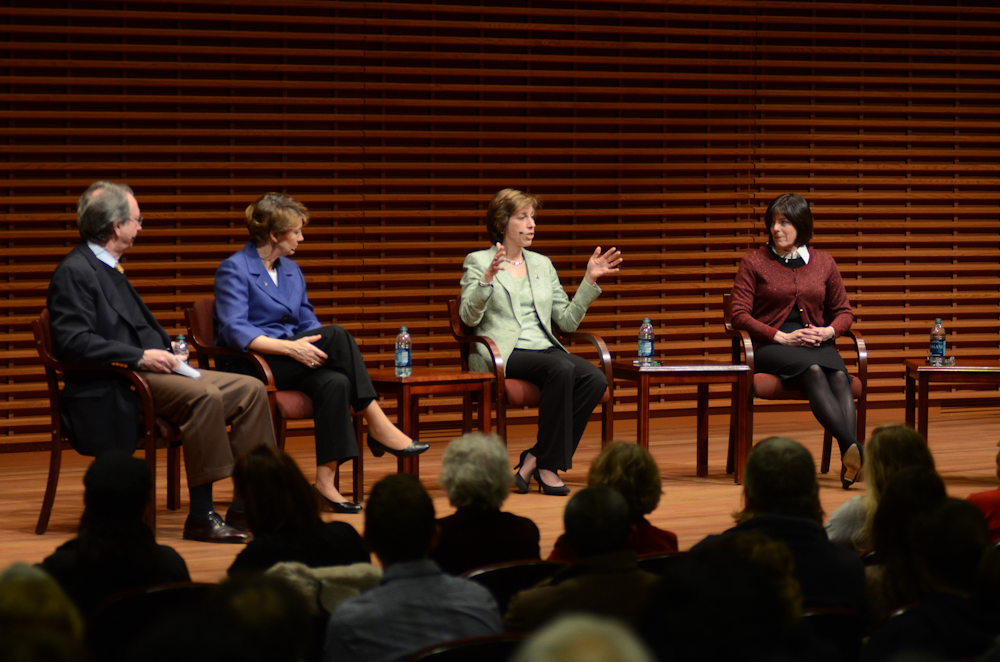“Stanford is the kind of place where you do think about achieving goals that are incredible and you do get encouragement from being around people that set those goals just like you do,” said Ellen Ochoa M.S. ’81 Ph.D. ’85, the first Hispanic woman in space, on Monday night in Cemex Auditorium at an event highlighting the accomplishments of three Stanford alumnae astronauts.

The program, Stanford Women in Space, showcased the accomplishments of Eileen Collins M.S. ’86, the first woman to serve as a shuttle commander, Barbara Morgan ’73, the first teacher in space, and Ochoa, the current director of the Lyndon B. Johnson Space Center in Houston, Texas.
Norm Robinson Ph.D. ’74, a former dean of student affairs and current staff emeritus, began the symposium by introducing moderator Scott Hubbard, professor of aeronautics and astronautics and former director of NASA’s Ames Space Center.
Before introducing the speakers, Hubbard brought the audience’s attention to the recent passing of Sally Ride ’73 M.S. ’75 Ph.D. ’78, the first woman in space, who Hubbard cited as a groundbreaking astronaut who paved the way for the three women on the stage.
Collins began an account of her time at NASA by describing the moment she realized she wanted to go to space as a fourth grader perusing a Junior Scholastic magazine and encountering a picture of the Gemini astronauts.
“It didn’t matter that there were no women in the picture, I just figured I could be an astronaut someday,” she said. “I carried that dream with me throughout the years, and I never told anyone I wanted to be an astronaut because I was worried they’d say I couldn’t do it.”
Ochoa followed by describing her time working for NASA, both as an astronaut and then later on the management side of the organization. Both Collins and Ochoa were selected to become astronauts during the 1990 recruiting season, and Ochoa noted that — by the time they were both in the program — women had become a much larger component of the NASA infrastructure.
Like Hubbard, Ochoa credited Ride for paving the way for future female astronauts, as well as the Stanford community for serving as an incubator for her lofty aspirations.
“While I was getting my Ph.D., Sally Ride flew for the first time, which gave me encouragement,” she said.
Morgan, the third woman on the panel, became an elementary school teacher before even considering becoming an astronaut. She credited Ronald Reagan’s televised appeal to teachers to apply for the Teacher in Space Program as the impetus for her desire to see space.
Morgan was chosen out of 10,000 applicants to serve as Christa McAuliffe’s back up for the Space Shuttle Challenger mission, which ended in tragedy after the spacecraft exploded 73 seconds into its flight.
After the crash, NASA reluctantly asked Morgan to become the new Teacher in Space designee, fearful that she would decline. However, that was far from her response.
“It was very easy to make the decision to accept,” she said. “We had school kids across the country watching adults in a terrible situation, and I thought it was right to let kids watch adults do the right things. How are we going to fix it if we don’t keep the future open for our kids?”
After the speakers introduced themselves, Hubbard fielded audience questions collected on note cards distributed before the program.
When asked what skills and accomplishments prospective astronauts should have under their belts before applying to NASA, all three women stressed the necessity of receiving advanced educations, citing their Stanford degrees and intellectual curiosities as beneficial assets.
Ochoa, who is currently in the process of choosing the astronauts of the 2013 recruitment class, emphasized this desire to learn.
“This year, we have 6,300 applications to be next astronauts, and we will only pick 10,” Ochoa said. “We look for curious people who like to learn. Good leaders, good followers and good team players.”
The women also responded to questions about the difficulties of raising families while pursuing full-time careers at NASA.
Though they all acknowledged the difficult balance, Ochoa noted that it was often easier to manage operations in the spacecraft than it was raising two young boys.
“I always thought that going on a family vacation required more organization than going on a shuttle flight,” she said.
The symposium concluded with Hubbard, widely known as the Mars Tsar for his involvement with NASA’s Mars Exploration Program, asking each woman if they would consider traveling to Mars, and if they did, whether or not they would want to return.
Each said they would like to visit the planet, with Morgan jokingly suggesting that she might not want to come back.
“Who knows that it will be like in 10, 20, 30 years,” she said with a shrug.
These three women are part of a group of seven female astronauts who have graduated from Stanford, including Ride and Mae Jemison ’77, the first African-American woman in space.
According to statistics provided by the Department of Continuing Studies, 525 people have flown in space since Yuri Gagarin’s landmark 1961 journey, but only 45 of them have been women, and seven of these women have Stanford degrees.
Hubbard suggested that despite the statistics indicating that fewer women became astronauts than men, there is a strong interest in joining NASA across the gender spectrum.
“Certainly in my own department at Stanford [there is], so there’s no lack of interest,” he said, noting that his first two Ph.D. students have been women. “We like to encourage diversity and for everybody to get involved in the space program.”
“I think Stanford promotes entrepreneurship,” he added. “I really feel as though the environment is one of encouraging everyone to start a company or fly in space.”
The Continuing Studies Program and Stanford Historical Society jointly hosted the symposium.
